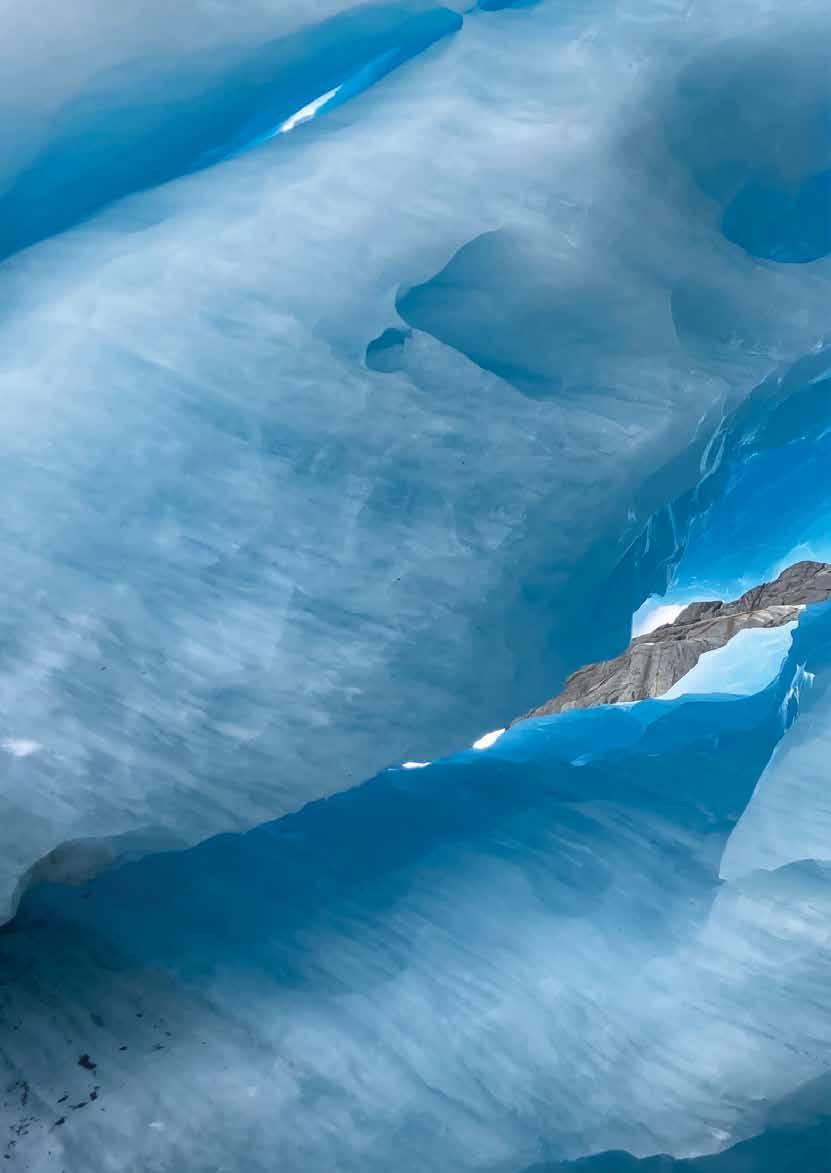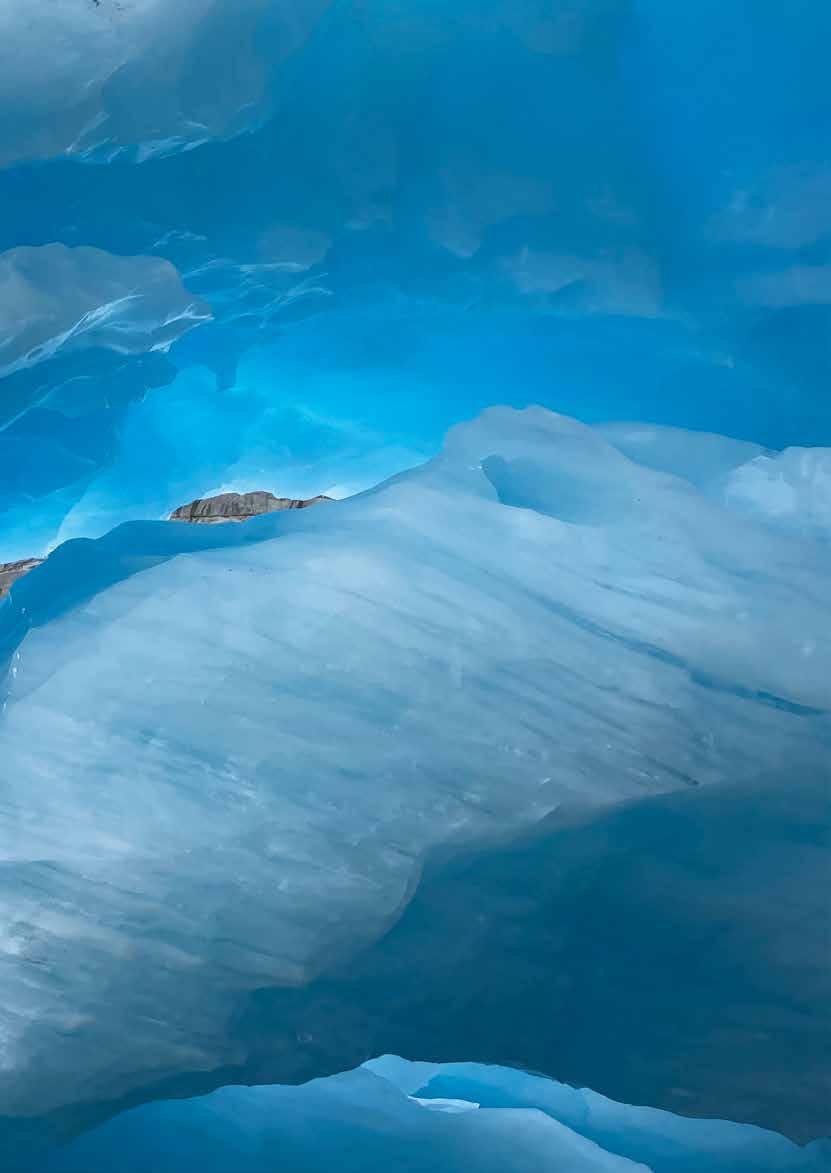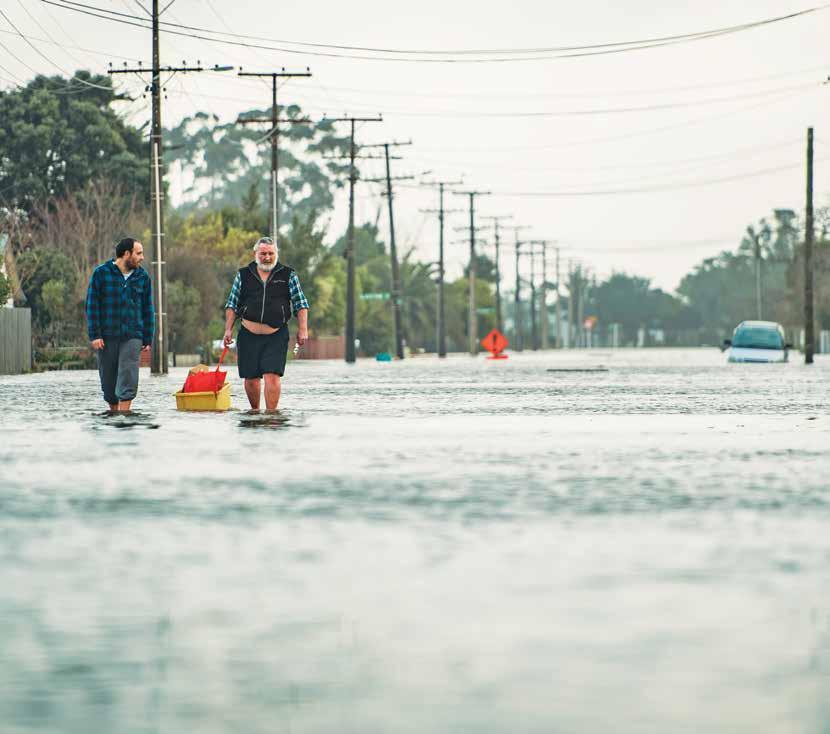
28 minute read
FOREWARNED IS FOREARMED
by NIWA_NZ
CHAIRMAN AND CHIEF EXECUTIVE REVIEW
In the early hours of Tuesday 22 March, a rain gauge in Northland was filled with 103mm of rain in just one hour – the most ever recorded at a low elevation weather station in Aotearoa New Zealand. Just eight months earlier, NIWA recorded the highest flood flow ever measured in New Zealand – 7640 cubic metres per second in the Buller River. That was 17 times its normal flow and 35 times the Huka Falls when they’re in full flow. That’s an awful lot of water. Flood waters surged towards Westport, spilling out over the floodplain, and leaving more than 120 homes uninhabitable.
Advertisement
Our climate and our world are changing, fast. 2021 was New Zealand’s hottest year since records began, and we’ve had the three warmest winters back-to-back. Our climate scientists have a clear warning – we must brace ourselves for more frequent and intense storms in the years ahead. NIWA can’t stop it raining, but we can help communities prepare and adapt. As New Zealand’s leading environmental science provider, our ability to accurately forecast hazards is rapidly evolving. Forecasting is central to what we do – with our continually improving processing power and precise modelling, we can more accurately predict when and where heavy rain will fall, where it will go once it hits the ground, and what may happen when it gets there. Our meteorologists and climate scientists, with concomitant investment in our data science capabilities and our High-Performance Computing Facility, have developed a state-of-the-art national river flow awareness tool. We can use this tool to translate high-resolution forecast data into advanced catchment flow projections – 48 hours in advance – for more than 50,000 catchments across New Zealand. When Westport flooded last year, this tool played a key role in managing the inundation, helping save lives and property. Bob Dixon, Westport’s Civil Defence Controller, said the advice they “were receiving [from NIWA] around the modelling and predictions matched, almost to the letter, what was happening on the ground,” adding that “it was great science to have in [their] back pocket, giving peace of mind about the decisions [they] made.”
Insurance Council figures show floods cost New Zealand a record $248 million in 2021. With around two-thirds of the population living in flood-prone areas, the health, homes and livelihoods of hundreds of thousands of New Zealanders are at risk. [NZ Defence Force]
We aren’t stopping there. NIWA natural hazards modeller Dr Emily Lane is leading a five-year, multi-partner research programme – Mā te Haumaru ō te Wai – which, for the first time, will map flood hazard and risk through a national lens. Dr Lane and her team are working with researchers, iwi, stakeholders, and government to investigate flood inundation hazard and risk, co-developing fair and equitable strategies for communities to become more flood resilient. These are just two of many forecasting programmes underway at NIWA. At the opposite end of the spectrum is our longestablished drought forecasting work, and we are currently working with the Ministry for Primary Industries to develop a new drought forecasting tool. The tool uses innovative climate modelling and the latest in machine learning. It will help farmers
and growers better prepare for periods of dryness and drought by updating daily, providing forecasts at a much higher spatial resolution than previously available. Since 2014 we have been collaborating with fellow Crown Research Institute GNS Science on a risk modelling tool for natural hazards called RiskScape. RiskScape is a flexible, detailed framework for calculating natural hazard consequences, and part of its strength lies in a fully holistic approach that accounts for people, buildings, infrastructure and the environment. It passed a significant milestone in 2022, being launched to the public under open licence. The RiskScape team took home the prize for Best Hi-Tech Solution for the Public Good at this year’s NZ Hi-Tech Awards, being personally congratulated on stage by Prime Minister Rt Hon Jacinda Ardern. We also launched new and improved software for use in weather, climate and environmental forecasting – Cylc 8. This software is enhancing our environmental information service by improving the efficiency and complexity of forecasts. Cylc is open source and used throughout the world by organisations such as the UK MetOffice and the US Air Force. To be forewarned is to be forearmed. Our corner of the world is highly prone to natural hazards – from flooding, which is our most frequent, to earthquakes, which are our most costly and deadly. We are using world-leading science, inspiring and embracing national and international collaboration, to ensure the best brains in the business are engaged to tackle these threats.
2021 hottest year on record
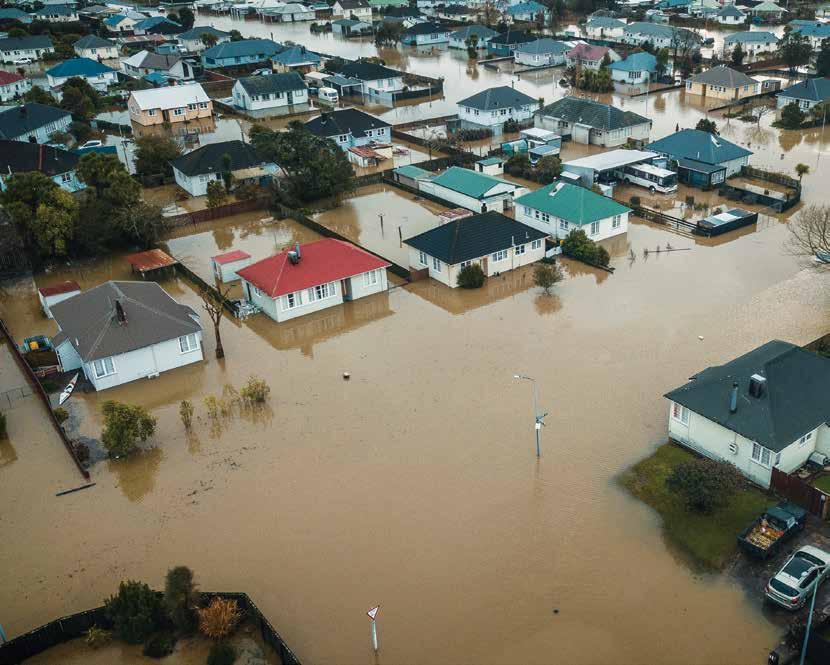
The July 2021 Westport flooding event included the largest direct measurement of river flow ever recorded by NIWA. It flooded over 400 houses and incurred insurance costs of around $56 million. NIWA flood risk calculations and modelling (below) helped inform the decision to evacuate residents ahead of time. [NZ Defence Force]
48h advance warning
NIWA’s new state-of-the-art national river flow awareness tool can translate high-resolution forecast data into advanced catchment flow projections – 48 hours in advance – for more than 50,000 catchments across New Zealand.

$41M
Investment in science infrastructure in 2022 Extraordinary demand for our services
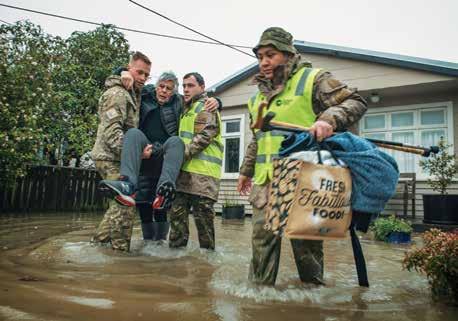
Despite the year’s challenges, the exceptional demand for our services is unabated, and we created 13 new permanent and fixed-term positions to help meet this challenge, growing our total staff to 725. We also welcomed three new board members – Janice Fredric, Professor Margaret Hyland and Dean Moana. NIWA finished the financial year strongly. Thanks to the commitment of our dedicated staff and management in pursuing all revenue opportunities, careful handling of costs and maximising operational productivity and efficiency, NIWA’s full year revenue was $170 million, just $1 million short of Budget. Investment in science infrastructure for national benefit increased substantially this year – from $23 million in 2021 to $41 million in 2022 – reflecting costs associated with the new science facilities in Hamilton as they near completion and progress on the experimental, commercialscale Recirculating Aquaculture System at our Northland Aquaculture Centre. Both are due for completion next year. NIWA was also successful in the 2021 Marsden Fund, being awarded funding for two standard applications, for a total of $1.826 million. We are also a collaborative partner with the University of Otago and Victoria University of Wellington on three other successful Marsden proposals. Pleasing results, given the fund is highly competitive – with a success rate of just 10.2%.
Financial summary for the year ended 30 June 2022
In thousands of New Zealand dollars
Revenue and other gains
– Research
– Commercial science
– Other income
Profit before income tax
Profit for the year
Capital expenditure
Adjusted return on average equity (%)
Return on average equity (%)
2022 2021 2020 2019 2018
170,233 *176,887 *158,860 161,292 151,416
95,614 109,111 93,800 94,901 91,516
74,618 67,775 65,059 66,390 59,899
1 1 1 1 1
8,958 22,594 9,982 8,708 9,074
6,470 16,263 7,370 6,247 6,472
40,817 23,080 14,757 21,460 33,573
5.0 13.9 6.9 6.2 6.9
4.3 11.6 5.7 5.1 5.5
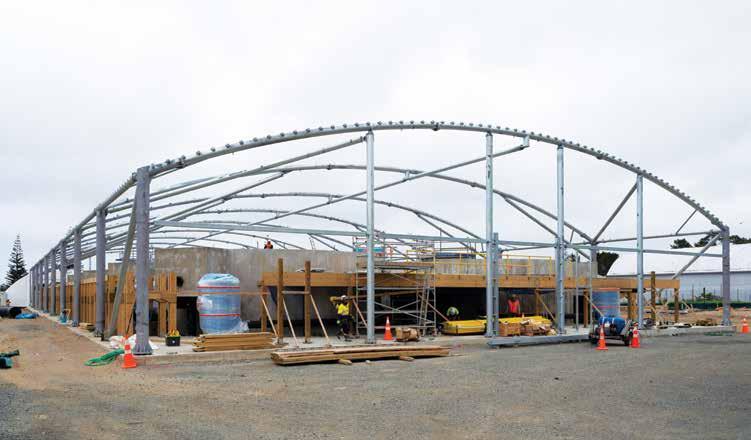
The new Recirculating Aquaculture System facilities at our Northland Aquaculture Centre will produce 600 tonnes of yellowtail kingfish annually. [Rob Murdoch]
24 KPIs
All 24 science KPIs achieved in 2022
NIWA infographics provided the Ministry of Education with innovative, easily understood, messaging about the benefits of ventilation in classrooms. Science highlights
Despite the national and international challenges presented by COVID-19, we achieved all 24 of our science Key Performance Indicators this year.
Climate science
The impacts of climate change are no longer warnings. They’re reality. After another year of extreme weather events, the need for NIWA’s expertise is compelling. In a demonstration of NIWA’s significance as a global climate change player, Principal Scientist Dr Olaf Morgenstern contributed as a lead author of Chapter Three of the IPCC Sixth Assessment Report, which looked at human influence on the climate system. The future was mapped out in five scenarios, and the key message reinforced the understanding that widespread and rapid changes in the global climate system are down to human influence. Researchers at NIWA’s Atmospheric Research Station in Lauder and NASA’s Goddard Flight Center have been examining the impacts of 2020’s devastating Australian bushfires and have discovered unprecedented changes to our stratosphere, which is where our protective ozone layer lies. Changes which revealed an important gap in our understanding of ozone chemistry. This discovery was both surprising and worrying, with wildfires predicted to become more frequent and more intense as the planet warms, the likelihood of ozone depletion is increased. A little closer to the ground, our air quality experts completed a ventilation study in three schools in collaboration with the

Ministry of Education. The advice the experts gave was that people use natural ventilation – such as opening doors and windows – to reduce the spread of COVID-19. This practice reduced both the number and severity of COVID-19 cases across the country, and the team subsequently secured a $500,000 project from the government to continue this work. When Westport’s devastating floods hit in July last year, NIWA’s national flood awareness system played a key role in deciphering the deluge of data coming at the West Coast Regional Council’s exhausted staff. Forecasting hydrologist Dr Céline Cattoën-Gilbert and her colleagues provided real-time advice on how to deal with the events that were unfolding, giving the council staff invaluable extra hours to protect property and evacuate people safely. The space industry is expanding rapidly all over the world, and NIWA has always been an integral component. Our involvement with MethaneSAT – a joint satellite initiative by the US and New Zealand – is reaching new heights, with the launch of a satellite next year. In a significant milestone, the New Zealand team has identified the best agricultural targets across the globe for the satellite to observe methane emissions and identify key targets for emission reduction in the battle to tackle climate change.
Freshwater science
New Zealand’s freshwater is often held to be one of our natural advantages. Yet the quality of the water in our lakes, rivers, streams, reservoirs and wetlands is highly variable, as is our water availability. In common with almost everywhere else in the world, our glaciers are retreating rapidly, and we are considering supplementary storage for hydroelectricity generation. Unlike much of the world, however, we have enough water – it’s just not always in the right place. There is much for NIWA’s team of 240 freshwater experts to do. Detection and management of invasive submerged weeds cost millions of dollars annually, but we have developed a solution – a portable invasive species detector that can be strapped to survey boats. This artificial intelligence-based detector has been trained to identify targeted invasive weed species and log their locations in real time, and it will enable agencies to survey far larger areas more efficiently than is currently possible. Estuaries are a point of interconnectedness, being the gateway between freshwater and saltwater. NIWA has channelled this interconnectedness through a twoyear project called Ki uta ki tai: Estuaries, thresholds and values. The programme will assess how different land contaminants interact with each other and affect estuarine health. Twelve estuaries have been selected as case studies, and our researchers are working with whānau, hapū, iwi and community groups to identify their aspirations. Wetlands are often overlooked, but they have highly significant and variable roles to play in maintaining environmental health, buffering flows, decreasing downstream flooding and boosting biodiversity. Well-designed constructed wetlands are a water quality restoration tool that can reduce levels of sediment, nutrients and microbes such as E. coli. This can significantly improve the water quality exiting the wetland and the ecology of downstream water bodies. In association with DairyNZ, we have been monitoring a purpose-built wetland on a Waikato farm, and developing guidelines on design, construction, maintenance and
NIWA scientists have been working with owners of farms such as this Waikato one to provide insights into how well their riparian plants have performed and advise on future planting projects. [Stuart Mackay]
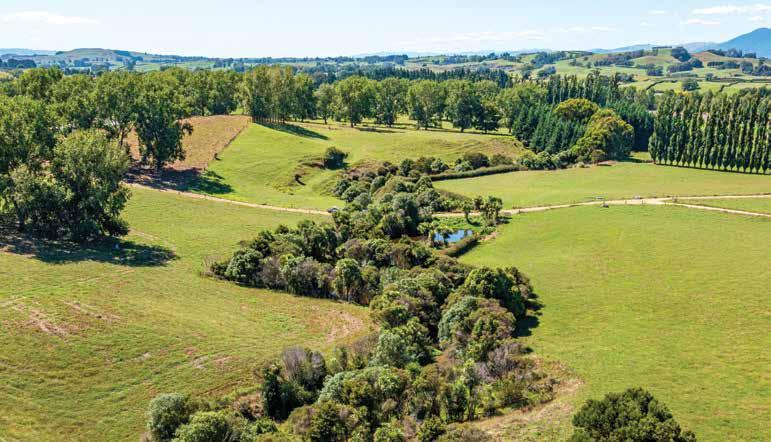
performance. The guidelines were launched in May this year and are freely available on DairyNZ and NIWA websites. We are also working with the Ministry for the Environment and the Department of Conservation to update the Fish Passage Guidelines in 2022, informed by a $7.2 million, five-year Endeavour Fund research programme that NIWA is leading to develop tools and guidance to reduce barriers to freshwater fish migration and improve the outlook for macroinvertebrate biodiversity and the abundance of iconic fish such as whitebait or freshwater eels.
Marine and aquaculture science
Over the course of this year, we have made significant progress on the construction of an experimental, commercial-scale Recirculating Aquaculture System (RAS) at the Northland Aquaculture Centre in Ruakākā. Built as a joint venture with Northland Regional Council, this land-based system is the first of its kind in New Zealand and will produce a quarter of a million kingfish (600 tonnes) annually. RAS answers the call for a more sustainable aquaculture industry. It offers immediate and near total control over the stock, with a significantly smaller environmental footprint due to its passive, secure environment, clean discharge and no requirement for servicing vessels. Completion is expected in early 2023. At the end of 2021, NIWA’s mid-sized research vessel Kaharoa completed a three-month Argo deployment voyage north of the equator, supported by the University of Washington, Scripps Institute of Oceanography and the Commonwealth Scientific and Industrial Research Organisation. For the next 5 years, the floats will provide freely accessible tropical ocean data critical to climate studies of global heat changes and circulation in the deep ocean. Incidentally, the vessel deployed its 2,000th Argo float on the voyage. This represents nearly half of the total number of floats currently operating across the global ocean, in what is the world’s largest marine science project. A collaboration with the Deep South Challenge: Changing with our Climate showed that New Zealand could experience very long and “very severe” marine heatwaves by the end of the century. It also found that the intensity of future marine heatwaves will increase by between 20% (best case) and 100% by the end of the century – what we now record as an intense marine heatwave will start to become the norm.
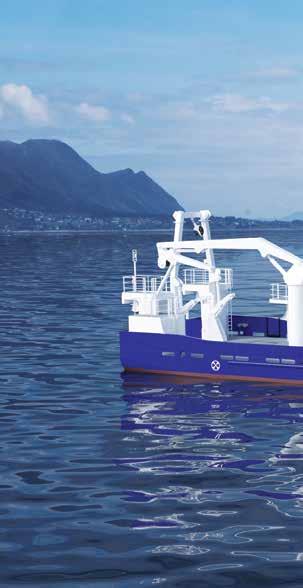
Prime Minister Rt Hon Jacinda Ardern presented Visa’s Best Hi-Tech Solution for the Public Good award at the NZ Hi-Tech Awards to the NIWA-GNS Science team for their RiskScape software. [NZ Hi-Tech Awards]

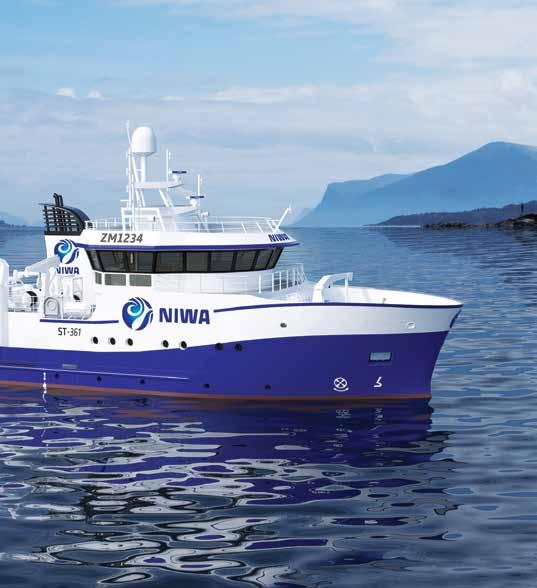
20–100%
A high-resolution mapping project has produced the first ever global estimates of coastal habitat damage caused by high-tonnage vessel anchoring. Working in collaboration with researchers from the University of Auckland and Auckland University of Technology, we used highresolution seafloor data, real-time ship tracking information, scientific literature and the news media. The damage is severe, long-lasting and widespread, with up to 6,000 square kilometres of damage worldwide. In Picton, for example, high-tonnage vessel anchors excavate the seabed by up to 80 cm, displacing enough sediment to fill an Olympic swimming pool.
Bespoke science facilities
Our facilities in Hamilton, Wellington and Christchurch are nearing the end of their useful life, and our strategic plan is to replace them with specially equipped, state-of-the-art, sustainable developments. The Hamilton facility is the first under development and, despite minor delays caused by COVID-19 and supply chain issues, it will be completed by mid-2023 and within the $45 million budget. These new complexes will protect NIWA’s ability to deliver its scientific activities for the foreseeable future. Their design reflects our sustainability values and will support our staff in being more flexible, collaborative, and creative, with specially equipped laboratories – helping ensure we can continue to provide the science needed to meet New Zealand’s rapidly changing needs.
The new replacement vessel for Kaharoa has been designed by naval architect Skipsteknisk and will accommodate 6 crew and up to 13 science staff. [Skipsteknisk]
An essential new marine research tool
Another upgrade has reached a significant milestone. Kaharoa – NIWA’s mid-sized marine research vessel – is an essential tool for oceanographic and fisheries research, but at 40 years old, it has significant operational limits and will be retired in 2025. Earlier this year NIWA signed a contract for the construction of its replacement – a 36-metre state-of-the-art research vessel that will be cost-effective, safe and efficient and capable of supporting future technologies and multidisciplinary science. This vital upgrade will allow NIWA to meet New Zealand’s future marine science needs, including the provision of data to inform fisheries management, critical oceanographic research – such as the response of the marine environment to a changing climate – biodiversity and biosecurity research and contributions to hazard risk management. This is a very significant investment in New Zealand’s research infrastructure, and an exciting development for NIWA and the marine science community.
Antarctic research
Holding 90% of the world’s ice and 80% of its freshwater, Antarctica has a profound effect on the planet’s oceans and climate. In February, a multidisciplinary group of NIWA researchers completed a mission to the world’s coldest continent, where they studied the Ross Sea Marine Protected Area (MPA). Three notable accomplishments were from Dr Denise Fernandez, who used Argo floats to collect information on the water column in the Ross Sea at different depths – these will stay in the ocean for several years; Dr Craig Stewart, who produced a real-time map of melt rates at the ice shelf’s edge; and Dr Craig Stevens, who drilled into an underwater river called the Kamb Ice Stream, discovering an unexpected swarm of life and recording an equallyunexpected pressure change as the tsunami from the Hunga Tonga–Hunga Ha’apai eruption made its way through the cavity.


Data science providing solutions
The Harvard Business Review described data science as the “Sexiest Job of the 21st Century”. We are living in a digital world and it’s hard to see a future that isn’t almost entirely digital. NIWA is a significant investor and innovator in artificial intelligence (AI) and computing solutions to ensure our research continues to provide the best scientific advice and solutions. Maui, the most powerful machine in NIWA’s High-Performance Computing Facility, is getting a mid-life makeover. The Cray XC-50 supercomputer was commissioned in 2018 and provides the processing power needed to deliver advanced data science services across NIWA’s research platforms. The addition of new graphic processing units will boost storage and deliver up to a four-fold increase in performance. This year, it was announced that Wellington is one of only 15 cities worldwide – selected from 631 applications – to be awarded US$1 million for the Bloomberg Philanthropies’ Mayors Challenge for the Digital Twin project. The project will be completed over the next three years and will visualise climate change and its consequences through virtual reality. NIWA scientists will contribute hypothetical scenarios using coastal modelling, coastal engineering and social science methodology. We are also designing an interactive map, so people can see what the Wellington coastline would look like with different severities of sea-level rise. Floods devastate large swathes of our country and communities, but can ultimately bring people together, so NIWA has utilised this ‘people power’ by launching the free NZ Flood Pics citizen science app. The public have been asked to contribute photos of flood-affected areas to a national database, which will support improved understanding of flood hazard and risk. Scallops are a national treasure, but there are major population declines nationwide. Collaborating with data scientists at the University of Canterbury, we have been working on an innovative, non-invasive alternative for surveying and harvesting them. Several thousand images of scallops were captured by underwater cameras mounted on an underwater drone, and then used to design algorithms to detect scallops.

Tiny eyes (about the size of a poppy seed) help scallops sense movement or predators (top). AI technology identifies individual scallops by sliding computer-generated stencils over video images (bottom). [James Williams]
Edgecumbe school children quiz former Te Kūwaha intern Ngāpera Keegan as she explains the lifecycle of tuna (eels) in a school outreach visit. [Rebekah Parsons-King]
The seabed mapping of the Hunga Tonga–Hunga Ha’apai volcano showed fine sandy mud and deep ash ripples as far as 50 kilometres away from the volcano. [NIWA-Nippon Foundation TESMaP]
This technology will provide accurate, efficient, safe and environmentally friendly surveys to improve our understanding of benthic habitats and marine ecosystems.
Partnering with Māori

Māori are intimately connected to the environment, and their worldviews are based on centuries of observation and anticipation of nature and genealogy. This complementary knowledge system can support kaitiakitanga and provide environmental research excellence, ensuring critical scientific endeavours are enduring, holistic, and steeped in culture. We continue to grow and strengthen our ties and partnerships with Māori. Te Kūwaha is NIWA’s National Centre for Māori Environmental Research – a dedicated Māori research team who undertake research, provide services across our science, and enhance the social, environmental, and economic aspirations of whānau, hapū and iwi, Māori communities and Māori business. This year was particularly poignant, with New Zealand celebrating its first ever official Matariki public holiday. Throughout our sites, we remembered those lost since the last rising, gave thanks for the present and looked forward to the year ahead. Events included the inaugural Matariki celebration in a packed house at NIWA Auckland, and speakers and artists enlightened NIWA Hamilton about the meaning and purpose of Matariki through their worldview. NIWA’s Te Kūwaha and People & Capability teams have been working together to develop a cultural competency framework for NIWA – “Te Puāwaitanga” – a concept that denotes learning and growth. Late last year, we completed an assessment of the cultural competency work underway across the public sector and settled on a modified model developed by Te Arawhiti (Office for Māori/Crown relations). The conceptual framework will guide us in assessing current competency levels and prioritising resources, while providing a benchmark for progression and success. As part of this work, we launched several new digital learning tools, such as the Taihoro Nukurangi app and Te Punga, and we are committed to building on this base to create enduring change. NIWA is also managing a two-year pan-CRI project to increase Māori participation in the science system, develop strategic pathways for graduates and work collaboratively across CRIs to provide mentorship and future opportunities. The project team continues to grow and recently welcomed NIWA social scientist, Jordan Luttrell, who brings a wealth of knowledge and experience in research evaluation methods and tools.
Working with others
There is a Māori proverb that speaks on the value of collaboration: Nāu te rourou, nāku te rourou, ka ora ai te iwi or ‘With your food basket and my food basket the people will thrive’. It started with a bang. On 15 January, the Hunga Tonga–Hunga Ha’apai (HT–HH) volcanic eruption reached a very large and powerful climax. The biggest explosion ever recorded by modern instrumentation sent shockwaves around the world. Some 16,500 km away, clouds above the UK lifted. Tsunamis killed two people in Peru and were detected in rivers deep under the Antarctic continent. Tonga was covered in ash and cut off from the world when its underwater internet cable was severed. For months, New Zealand’s skies turned dramatic shades of red and purple. A global event of this scale required an equally global effort to understand what happened and investigate the consequences. Thanks to generous support from Japan’s The Nippon Foundation, the receptivity of the Nation of Tonga, and innovative technology from the UK, the NIWA-Nippon Foundation Tonga Eruption Seabed Mapping Project (TESMaP) was born. On 9 April, NIWA’s deepwater research vessel Tangaroa set sail from Wellington for a month-long expedition to complete an undersea survey of the HT–HH volcano. The voyage achieved all its objectives and more. Tangaroa surveyed a remarkable 22,000 square kilometres of seabed in high resolution. Our scientists characterised and sampled sediments and rocks, captured 7,000 photographs and 32 hours of video footage, and took samples through the water column to identify the state of any surviving biota. The scientific learnings from this mission are vast and growing. The second part involves a high-tech USV (uncrewed surface vessel) from UK-based SEA-KIT International surveying the caldera, remotely operated all the way from Essex, England. The results from this survey are due later in the year. The HT–HH eruption highlighted just how remote and vulnerable our neighbouring Pacific Island Countries (PICs) are, being especially susceptible to natural disasters and climate change. To help build their resilience, the New Zealand Ministry of Foreign Affairs and Trade (MFAT) is funding NIWA and the Pacific Community (SPC) for a three-year project called PARTneR-2, in which we are collaborating with six PICs to help them better prepare for and respond to disasters. PARTneR-2 will address a critical gap across the Pacific region – the low availability and use of affordable and easily applied hazard
risk modelling tools for risk-informed and effective development decisions. Even further afield, NIWA is contributing to an international effort to help developing countries reduce the impact of biofouling on aquatic-based industries and environments. Biofouling is the build-up of aquatic organisms on underwater surfaces of marine infrastructure such as vessels, platforms and aquaculture installations. With the International Maritime Organisation GloFouling Partnerships Project, NIWA will help develop an economic assessment guide to determine the benefits of introducing a biofouling policy in 12 developing countries, including Indonesia, Mexico, Jordan, and Peru. Back in New Zealand, NIWA has teamed up with the other seven Crown Research Institutes (CRIs) to create the National Environmental Data Centre (NEDC) website, making the environmental information held by CRIs more accessible to all New Zealanders. The datasets include a huge range of information from climate and atmosphere, freshwater, land and oceans, including biodiversity and geological data. They will not only advance science, but also have a myriad of uses by Māori, central and regional government, businesses, researchers and the public. One of the starkest takeaways from the last two pandemic-affected years is proof that people can come together to achieve extraordinary things, without having to be in the same room, on the same site or even in the same country. New Zealand’s remoteness doesn’t hinder successful scientific collaboration – as our long-standing successful partnerships with the MetOffice in the UK and the National Oceanic and Atmospheric Administration (NOAA) in the US demonstrate, our work is often global, and our collaborative research with international partners has been just as fruitful as that with our partners here in New Zealand.
Committing to zero carbon
As we write this review, one-third of Pakistan is under water, sunken medieval villages have reappeared in European reservoirs and New Zealand’s Taranaki ski season may go a whole season without opening. For decades, the science has shown that to avoid the worst effects of climate change, global temperatures must not exceed more than 1.5°C above preindustrial levels. Yet, we are already living with the impacts of a warming climate, and they are often dramatic and devastating. We are horrified, along with the rest of the world, but we are not surprised, because the world is already 1.1°C warmer than it was in the 1800s, and emissions are continuing to rise. That is why, as the nation’s leading climate, freshwater and marine science organisation, NIWA must show strong leadership in our commitment to the target of carbon neutrality by 2025, consistent with the Government’s objective. We recognise that our research often has a substantial environmental footprint as we seek the solutions to allow government, Māori, stakeholders and the public generally to better manage their lives and their livelihoods, and we have continually adjusted our operations to minimise their environmental impact while ensuring we met our customers’ needs. Over the course of this year, we have worked under the Toitū Carbon Reduce Programme to verify and report greenhouse gas emissions and refine our strategies to manage and reduce impacts. Compliance with this programme is independently verified annually, and we participated in our first independent baseline certification and emissions reporting and monitoring accreditation in July. With construction accounting for 39% of global emissions, we’ve put sustainability at the heart of our programme to replace our ageing facilities in Hamilton, Wellington and Christchurch – utilising reusable materials, renewable energy and efficient practices. The emissions from our research vessels are our biggest carbon contributor, but the Kaharoa replacement will be a low emissions vessel and we tightly manage fuel use across the rest of our fleet. As with our motor vehicle fleet, we will continue to replace our boats when practical alternatives are available, and our long-standing adoption of advanced communications technology allows virtual meetings and continually challenges us to ask the question: “Why fly?”. Our most important and impactful contribution, however, is our science. NIWA’s research helps develop solutions to the world’s environmental problems. By ensuring our scientific endeavours have sustainability at their heart, we can continue to help build a healthy and productive world.
NIWA’s new Hamilton facility on the University of Waikato campus is scheduled for completion in mid-2023. [Blanton Benjamin, Foster Construction]
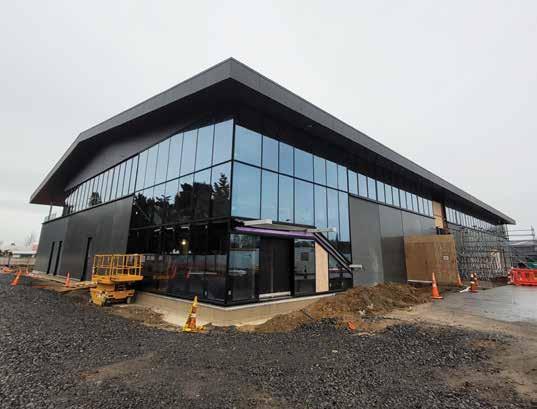
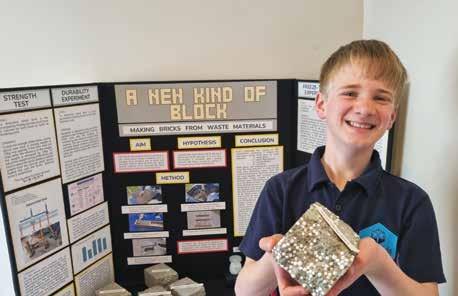
Newlands Intermediate student Dominic Holden (11) won the 2022 NIWA Wellington Science and Technology Fair with his project which aimed to reduce carbon emissions in the construction industry. [Chris Holden]
The next generation
You become strong by lifting others up, not pulling them down. NIWA has an ongoing commitment to build a future-ready, resilient workforce – one that is skilled and highly diverse. A skilled science sector will deliver innovation, growth, and quality, while a diverse sector will deliver creativity, connections, and accessibility. This year, NIWA co-supervised 67 PhD, 28 Masters and 4 Bachelor students nationwide, and financially supported 4 postdoctoral and 15 PhD positions. We are continuing to build Māori science capability through our oversubscribed Māori graduate intern programme. In 2021, the interns took part in our Cultural Keystone Species programme, which had hapū-driven research at its heart and was established to create more visible pathways for Māori science graduates. NIWA sponsors seven main city science and technology fairs and eight regional fairs, with our staff also serving on the judging panels. These fairs provide the opportunity for young people to think and act scientifically. By leading projects based on their own interests, they are taught to see science in the world around them and recognise it as a solution to global problems, large and small. This year’s fairs took place in person for the first time in two years and were enthusiastically welcomed by those taking part. Hundreds of students participate in each fair, showcasing innovative and creative projects on anything from an investigation about food serving sizes, to the future of rocket propulsion, and even the invention of a UV-powered cat bed. We are the principal science partner of BLAKE and work closely with them to support their focus on environmental leadership, especially with the nation’s youth. The 2022/23 cohort of five young New Zealanders will gain perspective in remote locations around New Zealand and Antarctica, building relationships and experience in the practicalities of science. We also sponsor the environment category of the annual BLAKE Awards and help inform their ‘Inspire for Teachers’ programme, which provides environmental education and leadership development for teachers. We are also part of the collective CRI sponsorship of the Sir Paul Callaghan Eureka Awards, and we provide an additional scholarship for a secondary or tertiary student who delivers the best presentation on climate, freshwater or marine science. COVID-19 put a spotlight on science, highlighting just how vital it is for finding solutions to our toughest problems. It also showed us that scientific endeavour can be filled with hope and that it touches the lives of everybody. NIWA exists to enhance Aotearoa New Zealand’s environment, economy and the lives of its people. By leading world-class environmental research, technology transfer and knowledge sharing, we play a critical role in guiding a resilient future for our nation and the rest of the world.
Barry Harris Chairman
John Morgan Chief Executive
Looking ahead
We are proud of the busy and successful year we’ve had at NIWA. Many of our projects, such as the property programme, TESMaP and our flood and drought forecasting work will be ongoing for the foreseeable future. We would like to thank everyone at NIWA – the Board, Executive Team and staff – for their dedication and support, particularly at the end of such a turbulent year. We knew that the pandemic would be tough, and it affected us in ways we could not have predicted. However, we remained resilient, and we adapted, emerging stronger, busier, and more focused than ever.

The following section of this Year in Review, ‘NIWA Science’, pp. 16–45, includes selected examples of how our science is applied for the benefit of the nation.
NIWA PHOTOGRAPHY AWARDS Brewster Glacier Emerging Photographer Award Winner - Fraser Goodmanson
The judges said this dramatic glacier image, taken from inside an ice cave, was made more impactful with the inclusion of the sliver of bare rock. They noted the lines, the texture and “a beautiful use of icy blue hues”.
